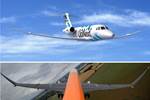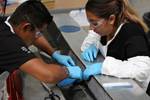Airbus eXtra Performance Wing demonstrator makes first flight
Maiden flight of the biomimetic adaptable wing establishes baseline for future fuel consumption reductions, sets milestone for ground testing and flights beginning 2024.

Photo credit: Airbus
Led by Airbus subsidiary and technology incubator UpNext (Madrid, Spain), the eXtra Performance Wing project, an initiative aimed at redefining aircraft wing technology to enhance flight performance and address environmental concerns, is showing continued progress. Through the application of biomimicry, the project endeavors to create a dynamically adjustable wing that maximizes aerodynamic efficiency in-flight, with the potential to substantially decrease fuel consumption.
The successful November maiden flight of the demonstrator, equipped with the final systems for eXtra Performance Wings, sets a crucial milestone for the project. Data gathered from subsequent flight tests will provide valuable metrics to assess the impact of this innovative wing design, including reductions in CO2 emissions and fuel consumption.
While the eXtra Performance Wing technology holds relevance for various aircraft and propulsion systems, the chosen demonstrator is a modified Cessna Citation VII business jet. With a targeted wingspan of more than 50 meters for the eXtra wing, the Cessna’s 16-meter wingspan, approximately one-third of the final design, strikes a balance between project complexity and design representation.
Launched in September 2021 as part of Airbus’ Wing Research portfolio, the eXtra Performance Wing project complements the Wing of Tomorrow program, exploring technologies for the next-generation of Airbus aircraft. Airbus UpNext is dedicated to accelerating future technologies through agile development and breakthrough innovation.
The project’s ultimate objective is to offer adaptable wing configurations that dynamically respond to flight conditions, incorporating active control technologies and physical wing structure modifications. Gust sensors on the aircraft’s front will detect turbulence changes, triggering relevant, automatic adjustments to optimize aerodynamic flow.
Additionally, hinged wingtips serve a dual purpose, preventing exceedance of maximum wingspan length on the ground and adjusting in-flight to alleviate wing pressure. These wingtips also enable an extended span for increased lift and reduced drag.
Extensive testing of a 3D-printed wind-tunnel model at Airbus’ wing research facility in Filton, U.K., has confirmed the concept’s feasibility. Manufacturing of various wing components is already underway, with contributions from Airbus’ four founding nations: the U.K. for wings, Spain for folding wingtips and Germany for the high lift system. Modification and assembly of the aircraft will take place in France.
Following initial flight testing, the demonstrator will be based in Cazaux, France, equipped with a remote operation system for communication testing. In 2024, the eXtra Performance Wings will be integrated and undergo ground testing, with first flights scheduled for 2025.
Remote piloting during flight testing will enable engineers to push the technologies to their limits, according to Airbus. The Cessna demonstrator, not intended for production, will not require human flight certification, allowing for comprehensive testing.
“We have a real opportunity here to make a contribution to reducing fuel burn,” Sebastien Blac, eXtra Performance Wing technical director, emphasizes. “Just having the potential to change the aerospace industry like this is huge.”
For related content, read “Airbus opens WTDC site to accelerate next-gen wing development.”
Related Content
-
A new era for ceramic matrix composites
CMC is expanding, with new fiber production in Europe, faster processes and higher temperature materials enabling applications for industry, hypersonics and New Space.
-
Manufacturing the MFFD thermoplastic composite fuselage
Demonstrator’s upper, lower shells and assembly prove materials and new processes for lighter, cheaper and more sustainable high-rate future aircraft.
-
Plant tour: Joby Aviation, Marina, Calif., U.S.
As the advanced air mobility market begins to take shape, market leader Joby Aviation works to industrialize composites manufacturing for its first-generation, composites-intensive, all-electric air taxi.
















